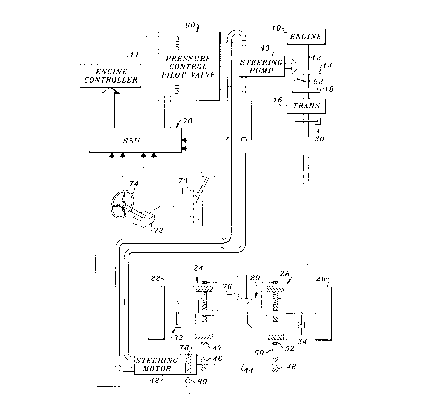Une partie des informations de ce site Web a été fournie par des sources externes. Le gouvernement du Canada n'assume aucune responsabilité concernant la précision, l'actualité ou la fiabilité des informations fournies par les sources externes. Les utilisateurs qui désirent employer cette information devraient consulter directement la source des informations. Le contenu fourni par les sources externes n'est pas assujetti aux exigences sur les langues officielles, la protection des renseignements personnels et l'accessibilité.
L'apparition de différences dans le texte et l'image des Revendications et de l'Abrégé dépend du moment auquel le document est publié. Les textes des Revendications et de l'Abrégé sont affichés :
| (12) Brevet: | (11) CA 2296249 |
|---|---|
| (54) Titre français: | SERVOCOMMANDE SENSIBLE A LA DIRECTION |
| (54) Titre anglais: | STEERING RESPONSIVE POWER BOOST |
| Statut: | Périmé et au-delà du délai pour l’annulation |
| (51) Classification internationale des brevets (CIB): |
|
|---|---|
| (72) Inventeurs : |
|
| (73) Titulaires : |
|
| (71) Demandeurs : |
|
| (74) Agent: | BORDEN LADNER GERVAIS LLP |
| (74) Co-agent: | |
| (45) Délivré: | 2004-04-06 |
| (22) Date de dépôt: | 2000-01-19 |
| (41) Mise à la disponibilité du public: | 2000-08-25 |
| Requête d'examen: | 2000-01-19 |
| Licence disponible: | S.O. |
| Cédé au domaine public: | S.O. |
| (25) Langue des documents déposés: | Anglais |
| Traité de coopération en matière de brevets (PCT): | Non |
|---|
| (30) Données de priorité de la demande: | ||||||
|---|---|---|---|---|---|---|
|
A steering control system for a tracked vehicle includes an engine driven
variable
displacement steering pump which drives a hydraulic motor. A control system
senses
steering wheel position, vehicle speed, engine speed and forward/reverse
vehicle direction.
As a function of these sensed inputs, a control signal is generated and is
used to control the
swashplate angle of an engine-driven variable displacement pump which drives a
steering
motor which drives a differential track drive mechanism. The control system
also
determines a ratio of motor speed to vehicle speed and generates a powerboost
signal
when the ratio exceeds a threshold value. The powerboost signal is
communicated to the
engine controller which causes the engine to increase its power output. This
modifies the
engine fuel delivery curve based on the steering system power requirement and
increases
the power available for turning the vehicle.
Note : Les revendications sont présentées dans la langue officielle dans laquelle elles ont été soumises.
Note : Les descriptions sont présentées dans la langue officielle dans laquelle elles ont été soumises.

2024-08-01 : Dans le cadre de la transition vers les Brevets de nouvelle génération (BNG), la base de données sur les brevets canadiens (BDBC) contient désormais un Historique d'événement plus détaillé, qui reproduit le Journal des événements de notre nouvelle solution interne.
Veuillez noter que les événements débutant par « Inactive : » se réfèrent à des événements qui ne sont plus utilisés dans notre nouvelle solution interne.
Pour une meilleure compréhension de l'état de la demande ou brevet qui figure sur cette page, la rubrique Mise en garde , et les descriptions de Brevet , Historique d'événement , Taxes périodiques et Historique des paiements devraient être consultées.
| Description | Date |
|---|---|
| Inactive : CIB de MCD | 2006-03-12 |
| Le délai pour l'annulation est expiré | 2006-01-19 |
| Lettre envoyée | 2005-01-19 |
| Accordé par délivrance | 2004-04-06 |
| Inactive : Page couverture publiée | 2004-04-05 |
| Inactive : Taxe finale reçue | 2003-12-30 |
| Préoctroi | 2003-12-30 |
| Un avis d'acceptation est envoyé | 2003-07-04 |
| Un avis d'acceptation est envoyé | 2003-07-04 |
| Lettre envoyée | 2003-07-04 |
| Inactive : Approuvée aux fins d'acceptation (AFA) | 2003-06-16 |
| Modification reçue - modification volontaire | 2001-05-09 |
| Demande publiée (accessible au public) | 2000-08-25 |
| Inactive : Page couverture publiée | 2000-08-24 |
| Inactive : CIB en 1re position | 2000-03-16 |
| Lettre envoyée | 2000-02-18 |
| Inactive : Certificat de dépôt - RE (Anglais) | 2000-02-18 |
| Demande reçue - nationale ordinaire | 2000-02-18 |
| Toutes les exigences pour l'examen - jugée conforme | 2000-01-19 |
| Exigences pour une requête d'examen - jugée conforme | 2000-01-19 |
Il n'y a pas d'historique d'abandonnement
Le dernier paiement a été reçu le 2004-01-05
Avis : Si le paiement en totalité n'a pas été reçu au plus tard à la date indiquée, une taxe supplémentaire peut être imposée, soit une des taxes suivantes :
Les taxes sur les brevets sont ajustées au 1er janvier de chaque année. Les montants ci-dessus sont les montants actuels s'ils sont reçus au plus tard le 31 décembre de l'année en cours.
Veuillez vous référer à la page web des
taxes sur les brevets
de l'OPIC pour voir tous les montants actuels des taxes.
| Type de taxes | Anniversaire | Échéance | Date payée |
|---|---|---|---|
| Enregistrement d'un document | 2000-01-19 | ||
| Taxe pour le dépôt - générale | 2000-01-19 | ||
| Requête d'examen - générale | 2000-01-19 | ||
| TM (demande, 2e anniv.) - générale | 02 | 2002-01-21 | 2002-01-18 |
| TM (demande, 3e anniv.) - générale | 03 | 2003-01-20 | 2003-01-17 |
| Taxe finale - générale | 2003-12-30 | ||
| TM (demande, 4e anniv.) - générale | 04 | 2004-01-19 | 2004-01-05 |
Les titulaires actuels et antérieures au dossier sont affichés en ordre alphabétique.
| Titulaires actuels au dossier |
|---|
| DEERE & COMPANY |
| Titulaires antérieures au dossier |
|---|
| BENJAMIN MICHAEL WITTE |
| DENNIS ROYAL YODER |
| JOHN WAYNE SCHLETZBAUM |
| LAWRENCE VERNON ANDERSON |
| RAYMOND YIFEI HOU |
| RONALD LEE MAYFIELD |
| SANJAY ISHVARLAL MISTRY |